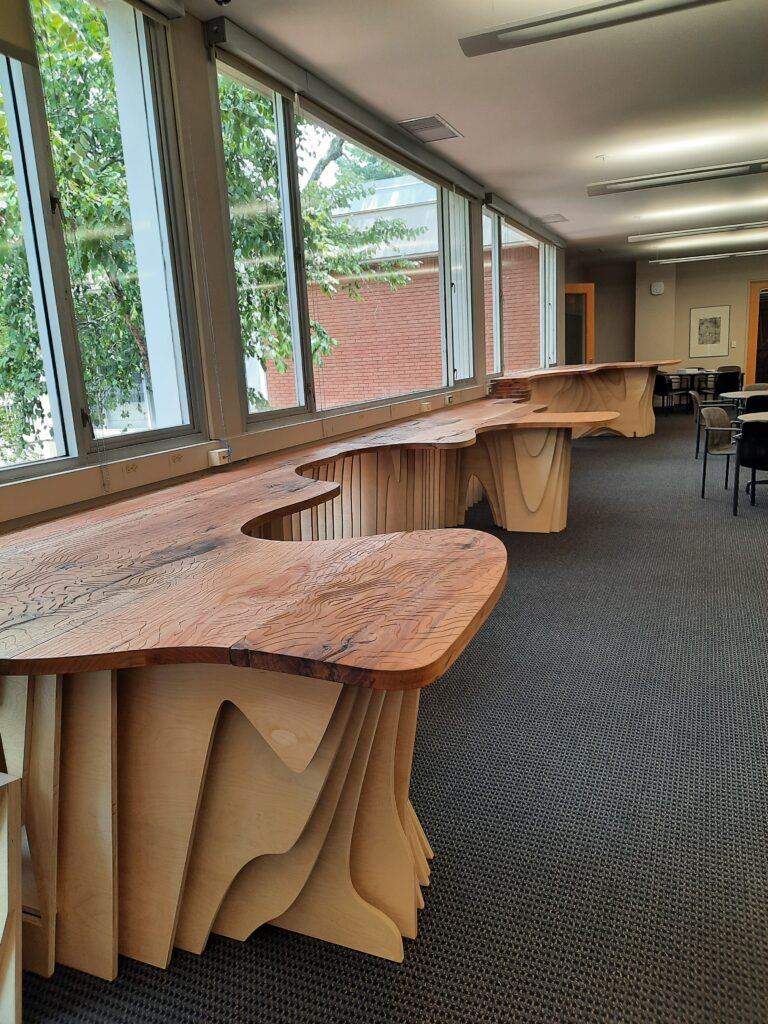
Clemson, SC
The Gunnin Architecture Library has a new addition, thanks to the work of students in a summer design-build studio.
Twenty students from the class, all architecture majors, worked on the project to design, fabricate and install a new piece of furniture for the Gunnin Library. The class, taught by Joel Brown, lecturer and manager of the Craft and Computation Labs for the School of Architecture, was titled digital fabrication in architecture. The idea for the class came about in the Spring semester, when the Gunnin Library hosted a design charette to get input from architecture students on how to best use its space to meet students’ needs.
More seating in the library, especially window seating, was one of the needs identified in the charette, and after consulting with Gunnin Library Director Ann Holderfield, Brown thought it would make a great project for his design-build studio.

Students worked together in pairs to come up with design concepts, which were then narrowed down to the final design. The students then divided into teams to tackle different aspects of the project, such as fabrication, installation, documentation of the process, and the presentation of the finished product. The result was a 40-foot-long, three-piece table made from Red Oak sourced from campus trees that had been cut down. The table has many curves that allow for different seating configurations and perspectives; because of the curves, the depth of the table varies from 6 feet in some places to 16 inches at others. The top of the table features topographical carvings based on the actual topography of Clemson’s campus.
Students were involved in every step of the process, from meeting with Holderfield to discuss the library’s needs to gluing and screwing the table together. Brown said the whole goal of the class was to give students a true real-world experience.
“The main thing was teaching them how to work with a client within a specific timeframe and on a budget,” he said. “I wanted this to be a realistic project similar to what they will see when they go out into the profession, so they could see how the drawings they put on paper translate into a fabricated and installed product.”
“This studio has been one of my favorite experiences during my time as an architecture student,” said senior Will Pitts. “To actually see a design get built has provided a whole new perspective. I have learned real-world challenges such as cost and budgeting, essential wood shop and material skills, and the constant collaboration towards an end goal.”
The table now sits against the windows in the Gunnin Library overlooking a courtyard, providing additional workspace and seating for students and other patrons.

“It was really amazing working with the students. They listened intently, asked me focused questions, and put so much thought into their designs,” said Holderfield. “I was so impressed by how well I was heard and by their creativity, as well as their flexibility to shift into the larger groups and work together to create in the next round. Some students would check in with me to get my feedback over particular details, too. Every student in this class jumped right into the project and worked really hard on it. I could tell that they all cared so much.”
Holderfield not only served as the client for the project, but she also assisted them as a librarian, connecting them to architecture databases, books about design and other resources in their research on libraries and library design. She said she enjoyed working with the students throughout the process and was excited for the library to serve as an experiential learning space for the students who use it.
“One of the students in the presentation shared that they never get to see their designs come to life and how much it meant to him to be able to see it. I love that the library was a space where the students could turn their ideas into a reality and a tangible experience,” said Holderfield.
No Comments
Block this user
Are you sure you want to block this user and hide all related comments throughout the site?
Archinect
This is your first comment on Archinect. Your comment will be visible once approved.